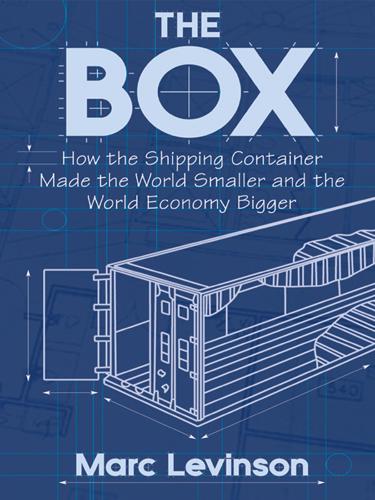
The Box: How the Shipping Container Made the World Smaller and the World Economy Bigger
by
Marc Levinson
Published 1 Jan 2006
The capacity of containerships and cranes, however, was determined by the quantity of containers rather than their weight, and by the mid-1960s ports and ship lines began to emphasize the number of containers they handled. Raw numbers proved problematic, because they failed to distinguish between empty containers and full ones, and between large containers and small ones. In 1968, the Maritime Administration began to report container traffic in standardized 20-foot equivalent units, or TEUs. A 40-foot container represents 2 TEUs, and one of Matson’s 24-foot boxes registered as 1.2 TEUs. Chapter 12 The Bigness Complex Malcom McLean sold his stock and quietly left the board of R.
…
There is certainly no contemporaneous evidence for it. I suspect that the story of McLean’s stroke of genius took on a life of its own as, decades later, well-meaning people asked McLean where the container came from. As I show in chapter 2, ship lines and railroads had been experimenting with containers for half a century before Malcom McLean’s trip to Jersey City, and containers were already in wide use in North America and Europe when McLean’s first ship set sail in 1956. Malcom McLean’s real contribution to the development of containerization, in my view, had to do not with a metal box or a ship, but with a managerial insight. McLean understood that transport companies’ true business was moving freight rather than operating ships or trains.
…
When the Europe-Australia conference set container rates in 1967, a year before containership service opened, it decreed that each commodity in a mixed container would be charged the per-ton rate for that commodity. The only way to find the correct rate was to open the container and weigh every single item inside.24 This economically illogical system could not last. Ship lines had no reason to care what was inside the containers they carried, and with rampant excess capacity they were willing to accept any payment that exceeded their cost to carry the container. By early 1967, Waterman Steamship, Malcom McLean’s former company, switched to a flat rate for shipments from the United States to southern Europe: $400 for a shipper-owned 20-foot container, $800 for a 40-foot container, regardless of the contents.
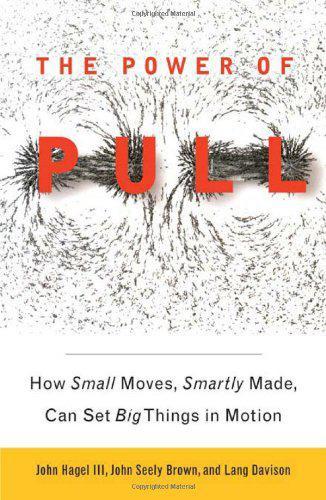
The Power of Pull: How Small Moves, Smartly Made, Can Set Big Things in Motion
by
John Hagel Iii
and
John Seely Brown
Published 12 Apr 2010
Like Olympic snowboarders practicing moves in 2009 that were undreamed of in 2006 (such as the double-corked 1260—a spin cycle of three and a half rotations and two off-axis flips), or competitive surfers learning the next aerial maneuver, they know that today’s level of achievement will not be sufficient tomorrow. You might think that such goals are only for performers at the highest levels—Olympic athletes, CEOs, best-selling recording artists. But in truth they’re for everyone. In fact, one of our examples, Malcom McLean, who changed the way the world shipped everything with the introduction of the shipping container in 1946, started off driving a truck for someone else. It is no accident that these early examples of performance improvement come from various edges, because it is exactly at the edge that the need to get better faster has the most urgency. Incumbents at the core—which is the place where most of the resources, especially people and money, are concentrated, and where old ways of thinking and acting still hold sway—have many fewer incentives to figure out the world, or to discover new ways of doing things, or to find new information.
…
In Salesforce.com’s early years, for example, founder and CEO Marc Benioff painted a compelling view of how to reshape the software industry around a new form of delivery: software as a service. The Fung brothers revolutionized supply-chain practice in the apparel industry. Malcom McLean led Sea-Land to a preeminent position in the containerized shipping business by driving standardization around his innovative container designs. And Dee Hock helped Visa make an exemplary shaping move in the 1970s at a time when banks had gotten into difficulty by aggressively sending out preapproved credit cards (even to newborns and family pets) without the infrastructure needed to support such large-scale transactions, or to sufficiently guard against fraud.
…
Google’s AdSense platform uses technology to connect advertisers, content providers, and potential customers, but its real value consists in a set of protocols and practices governing how ads are submitted, presented, and paid for, enabling participants to generate value from the platform with minimal investment of time and effort and minimal oversight from Google. Malcom McLean, the founder of Sea-Land and a successful shaper of the global shipping industry, employed a very different kind of shaping platform to provide interaction leverage. He developed an innovative design for four corner fittings and twist-lock mechanisms on shipping containers. By making these designs available to the broader shipping industry, he encouraged a broader set of investments by port authorities, crane companies, and shipping companies that accelerated the adoption of containerized shipping.
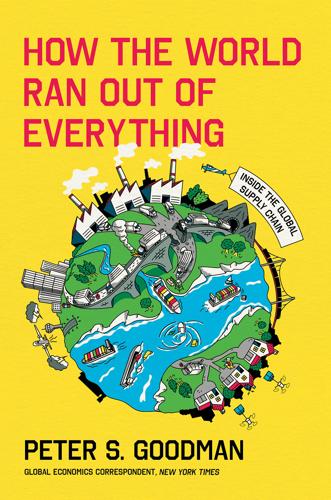
How the World Ran Out of Everything
by
Peter S. Goodman
Published 11 Jun 2024
But its development in the middle of the twentieth century represented a crucial technological breakthrough. Shipping containers could be stacked atop others on enormous vessels, then plucked easily off the decks by crane and deposited on the docks. That basic feature had dramatically accelerated the movement of cargo. It had effectively shrunk the oceans, compressing the distance between shores. There was no global supply chain without the shipping container. There was no Just in Time. The whole system of moving goods around the planet revolved around the container. All of that had come to pass because of the innovation of a man named Malcom McLean. McLean was not trying to change the world.
…
For multinational retailers, this was like fertilizer for their ambitions. They relied on the easy availability of container vessels to construct Just in Time supply chains spanning oceans, while treating transportation as a trifling cost. From Europe to the United States, consumers reaped the gains via inexpensive imports. Zara, H&M, Uniqlo: all benefited from monumental scale and cheap shipping rates. But somewhere between Malcom McLean’s Ideal-X and another now-infamous ship, the Ever Given, the merits of scale began to work in reverse. The Ever Given was loaded with eighteen thousand containers when it hit the side of the Suez Canal in March 2021 and remained lodged there for six days.
…
Lopez and the rest of his union were the descendants of those who had endured a decades-long campaign by the shipping industry to reduce them to insignificance. The container had been a major advance in this battle, delivering a monumental leap in efficiency and sharply reducing the need for longshore workers. But that was not the end of the story. Robots were poised to finish the job. Three years after Malcom McLean’s first voyage out of Newark, the costs to ship many goods remained so high that they reached one-fourth the expense of manufacturing the product. As much as three-fourths of the costs of ocean shipping20 were captured by activities undertaken while ships were docked. The container shrunk those expenses by limiting the time that a ship needed to remain in port.

Atlantic: Great Sea Battles, Heroic Discoveries, Titanic Storms & a Vast Ocean of a Million Stories
by
Simon Winchester
Published 27 Oct 2009
One of the most effective early ways of bringing order to what was a historically ramshackle industry—an industry unchanged in its operating principles since the Phoenicians loaded murex shells in Mogador three thousand years before and shipped them back to Tyre—was that taken in the mid-1950s, when an American trucking executive named Malcom McLean hit on the idea of packing cargoes into enormous steel boxes—shipping containers. Up until then, cargoes—whether they were bags of potatoes, bales of cotton, bottles of whisky, motorcars, or machine guns—had all been loaded deep into a ship’s hold by cranes, then stacked as best as their shapes and sizes would permit, by gangs of expensive, often corrupt, and rigorously unionized stevedores—in the kinds of scenes so memorably recorded by Elia Kazan in On the Waterfront. The advantage of using standard-sized containers, twenty or forty feet long, and into which makers and merchants packed their own goods at the factory or the farm, was that the boxes could be put onto trucks or railroad flatcars, taken to the dockside, and loaded swiftly by specially made cranes onto the upper parts of a waiting ship as well as down in the holds.
…
Those who retain a fondness for clipper ships, for quinquiremes, or even for dirty British coasters long rue the day that these boxy monstrosities, which must be among the most familiar emblems of today’s globalized world, were ever invented. But Malcom McLean—who tried his first ship out in the Atlantic Ocean, in April 1956, running a converted U.S. Navy tanker, the Ideal-X, from Newark to Houston, with fifty-eight containers—knew that in the shipping industry time was everything and money was everything, and that to load a ton of cargo by hand cost nearly six dollars, while to do so on a containerized ship—indeed, on the Ideal-X itself, that late spring day—cost only sixteen cents.
…
New rules have recently been put in place, in both the Baltic and the North Sea, limiting the amount of sulfur in marine diesel fuel, in the hopes of cutting pollution and lessening the possibility that the satellites will be able to spot the ship tracks from the clouds the vessels leave above them. The world-changing idea of placing marine cargoes into same-size steel boxes, and creating the so-called container ship, belongs unequivocally to a former truck driver from North Carolina, Malcom McLean. There are also some brand-new ideas. One that has gained some traction, literally, is to have an immense sail, or a spinnaker-like kite, that can be played out ahead of a great cargo vessel when the wind is right, to help tow her along even though her engines might be cut off.

Frostbite: How Refrigeration Changed Our Food, Our Planet, and Ourselves
by
Nicola Twilley
Published 24 Jun 2024
Today she manages the farm alongside her husband and kids, while still working full time as the director of refrigerated services for Maersk, one of the largest container companies in the world. Reefers currently make up just 6 or 7 percent of global container capacity, but shipping firms can charge significantly more to carry them than their standard, “dry” forty-foot counterparts. Unrefrigerated shipping containers made their commercial debut on a rainy Thursday in 1956, when Pratt was not yet two years old. These now-ubiquitous metal boxes were the brainchild of Malcom McLean, the forty-two-year-old son of a poor North Carolina farmer who had built his own successful trucking empire and then sold it all in order to buy a struggling steamship line, despite never having set foot on a boat in his life.
…
On containerization, I also referenced the following: “Malcolm Purcell McLean, Pioneer of Container Ships, Died on May 25th, Aged 87,” Economist, May 31, 2001; Betty Joyce Nash, “The Voyage to Containerization,” Economic History, 2012, pp. 39–42; Brian J. Cudahy, “The Containership Revolution: Malcom McLean’s 1956 Innovation Goes Global,” TR News, no. 246 (September–October 2006); Sarah Murray, “World Would Be Lost without Big Metal Box,” Weekender, April 29–30, 2006; “Tankers to Carry 2-Way Pay Loads,” New York Times, April 27, 1936, p. 54; Judah Levine, “The History of the Shipping Container,” Freightos, April 24, 2016; Jean-Paul Rodrigue, Theo Notteboom, and Athanasios Pallis, “The Changing Geography of Seaports,” in Port Economics, Management and Policy (New York: Routledge, 2022); Leah Brooks et al., “The Local Impact of Containerization” (working paper, Division of Research and Statistics, Board of Governors of the Federal Reserve System, April 28, 2021); Anna Nagurney, “Global Shortage of Shipping Containers Highlights Their Importance in Getting Goods to Amazon Warehouses, Store Shelves and Your Door in Time for Christmas,” Conversation, September 21, 2021; “Banana-Shipping Invention to Cut Hundreds of Longshoreman Jobs,” South Florida Sun Sentinel, May 8, 1989; Haylle Sok, “50 Years of Container Refrigeration Innovation,” Global Trade Magazine, December 27, 2017; “Drewry: Shipping Line Share of Reefer Market to Hit 85% by 2021,” Container Management, September 27, 2017; “Tuna Travels,” Maersk, January 21, 2020; and John Churchill, “The Queen of Cool,” Maersk Stories, May 10, 2013.
…
I found the following books helpful to understand the story of container and reefer shipping: Alexander Klose, The Container Principle: How a Box Changes the Way We Think (Cambridge, MA: MIT Press, 2015); Marc Levinson, The Box: How the Shipping Container Made the World Smaller and the World Economy Bigger (Princeton, NJ: Princeton University Press, 2006); and Thomas Taro Lennerfors and Peter Birch, Snow in the Tropics: A History of the Independent Reefer Operators (Boston: Brill, 2019). On containerization, I also referenced the following: “Malcolm Purcell McLean, Pioneer of Container Ships, Died on May 25th, Aged 87,” Economist, May 31, 2001; Betty Joyce Nash, “The Voyage to Containerization,” Economic History, 2012, pp. 39–42; Brian J.
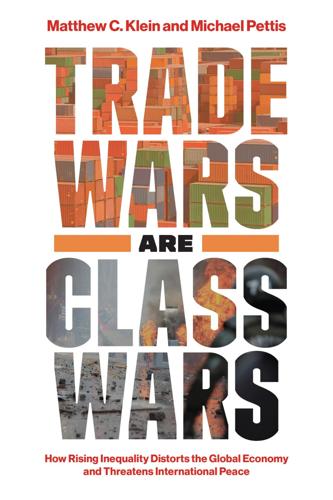
Trade Wars Are Class Wars: How Rising Inequality Distorts the Global Economy and Threatens International Peace
by
Matthew C. Klein
Published 18 May 2020
Corrupt Vietnamese generals often stole the most desirable items for themselves. Worse, most of the American soldiers who needed supplies were nowhere near Saigon. Getting them their gear from the docks required trucks driving on dirt roads for weeks, often in hostile territory. Desperate for better results, the U.S. Army hired Malcom McLean, the original innovator of container shipping, to build and operate a container port at Cam Ranh Bay. He had two conditions: each box would be packed with a single type of item, and each box would be packed for a specific unit, which would be responsible for returning it. Within months, McLean had solved the army’s logistics problem and shown the world what was possible with containerization.
…
Containerization also cut the opportunities for theft by longshoremen and teamsters, which explains why Scotch whisky exporters were among the earliest adopters. Moreover, container ships, unlike traditional cargo ships, could be loaded and unloaded simultaneously. When the first container ships were introduced, these innovations cut the time in port from days to hours. Ships now carry about ten times as many containers as they did in the 1960s, but the biggest ones still spend far less time in port than the typical freighter in the precontainer era. American entrepreneurs began commercializing container transport in the late 1950s, but even after demonstrating the potential for cost savings and speed, the idea did not fully catch on until the 1980s.
…
There was no sense in producing goods for export unless the customer had already ordered it, and there was little reason to order goods from abroad unless local substitutes were literally unavailable. Prepacking goods at the factory into standardized metal containers revolutionized this process. The same box could be used interchangeably across all modes of transportation. Trucks and trains could arrive at a port, drop off their cargo, get new containers, and roll off to their next destination in a matter of minutes. Even heavy containers could be moved quickly and safely by a handful of people using cranes. The hard work of packing and unpacking would only be done at the beginning and end of the entire trip, rather than at the beginning and end of each leg.
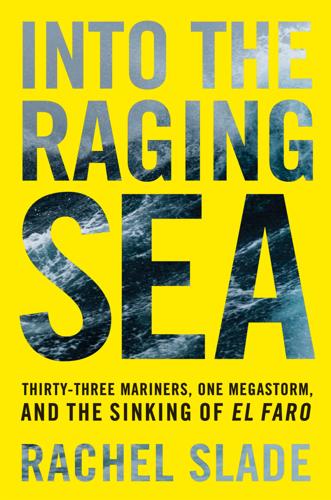
Into the Raging Sea
by
Rachel Slade
Published 4 Apr 2018
No doubt, containerization would destroy thousands of dockworkers’ jobs. For these reasons—the considerable outlay of cash coupled with insurmountable labor resistance—containerization took a while to catch on. But you couldn’t fight progress for long. In the mid-’50s, North Carolina–based trucking tycoon Malcom McLean developed a complete containerization system, which he launched with a single experimental ship in 1957. A year later, his company inaugurated containerized service between the US and San Juan, Puerto Rico. Over the next decade, all eyes were on McLean’s SeaLand, the revolutionary shipping company that had bet on containerization.
…
On the dock below the crane, a longshoreman steers a flatbed truck into position next to the ship, then releases the clamps holding the container to the truck’s chassis. A typical container is forty feet long and can be as heavy as thirteen cars. The crane operator uses cables and winches to lower the “spreader” over the steel box—a steel frame that aligns with the container’s top four corners—and locks it in place like a tight-fitting lid. The spreader grips the container as the operator artfully swings it above El Faro’s deck, accommodating for the box’s languid movement, and just as momentum begins to pull it backward, he lowers it into its designated spot, using gravity’s pull to level it into place.
…
The first thing the CURV revealed was the miles-long and -wide path of debris and containers. As the loaded freighter went down, everything she held peeled off, leaving a trail for the CURV to follow, like breadcrumbs in the forest. Some containers opened as they made their rapid journey three miles to the bottom, scattering their contents onto the soft ocean floor. Cars spilled out of the ship’s hull in slow motion, their components breaking free and raining down. The site looked like a murky gray sprawling city made entirely of junk. Tom saw a bicycle. Car batteries. Crumpled containers everywhere. Flung about was the eerily familiar detritus of modern life—a printer, a microwave, the top of a car, abstractly rendered in the foreign dusty desert of the deep Atlantic.
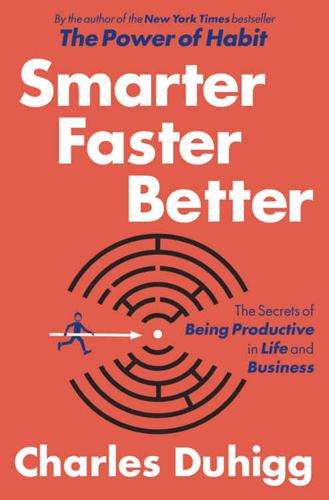
Smarter Faster Better: The Secrets of Being Productive in Life and Business
by
Charles Duhigg
Published 8 Mar 2016
Productive people and companies force themselves to make choices most other people are content to ignore. Productivity emerges when people push themselves to think differently. When I was working on this book, I came upon a story that I loved, one of my favorite bits of reporting. The tale involved Malcom McLean, the man who essentially created the modern shipping container. McLean died in 2001, but he left behind videotapes and numerous records, and I spent months reading about him, as well as interviewing members of his family and dozens of his former colleagues. They described a man who had relentlessly chased an idea—that shipping goods inside of big metal boxes would make docks more productive—and how that insight eventually transformed manufacturing, the transportation industry, and the economies of whole continents.
…
Less than a quarter mile away, in another portion of the sea that seemed essentially the same, that diversity would plummet and you might find only one or two kinds of coral and plants. Similarly, some pockets of Australia’s rain forests contained dozens of different types of trees, lichen, mushrooms, and vines flourishing side by side. But just a hundred yards away, that would dwindle to just one species of each. Connell wanted to understand why nature’s diversity—its capacity for creative origination—was distributed so unevenly. His quest began in the Queensland rain forests: 12,600 square miles that contain everything from forest canopies to eucalyptus groves, as well as the Daintree tropical forest, where conifers and ferns grow right at the edge of the sea, and the Eungella National Park, where trees are so dense that, at ground level, it can be nearly lightless in the middle of the day.
…
They hadn’t become less intelligent or less aware of the world. Their old personalities were still inside, but there was a total absence of drive or momentum. Their motivation was completely gone.” II. The room where the experiment was conducted at the University of Pittsburgh was painted a cheery yellow and contained an fMRI machine, a computer monitor, and a smiling researcher who looked too young to have a PhD. All participants in the study were welcomed into the room, asked to remove their jewelry and any metal from their pockets, and then told to lie on a plastic table that slid into the fMRI. Once lying down, they could see a computer screen.

More: The 10,000-Year Rise of the World Economy
by
Philip Coggan
Published 6 Feb 2020
In addition, labour relations were poor and strikes were common: dockers’ wages could eat up half the costs of an ocean voyage.48 Indeed, an academic study found that “the handling of cargo was almost as labour-intensive after World War II as it was during the beginning of the Victorian Age”.49 In the 1950s, a businessman called Malcom McLean tried to tackle the inefficiencies of the industry. He wanted the containers carried on his company’s trucks to be loaded straight on to ships. But this required wholesale changes in the design of ships, the operation of docks, and the working conditions of dockers; something that was bound to be opposed by the unions. So he established a new port in Newark, New Jersey, on the other side of the river from Manhattan. On April 26th 1956, the first container ship, SS Ideal-X, set off for Houston, Texas. Cranes that could lift the boxes on and off the redesigned ships had to be installed.
…
Then the product is sent by truck to distribution centres and eventually stacked on shelves by retail employees. And then think big. Travel to a container port, like Felixstowe in Suffolk, on England’s east coast, and you are in a land of giants. When I visited, a Maersk container ship, around 400 metres long, was ready to depart the dock. Its deck was filled with metal containers piled eight high; as many containers were below deck as above it. Three cranes, 80 metres tall, sat idly alongside. Their loading job was done. Within a few weeks, thousands of consumers would be using stuff taken from one of those containers. The world economy involves this mixture of the big and the small on a daily basis.
…
It is admittedly a very small farm; a converted container of the kind that fills the world’s merchant ships. Inside the box you can find lettuce, kale, flowers, even wasabi; all growing in a carefully temperature-controlled environment. As you enter the container, the first thing you see is a set of trays. Seeds have been planted in them, inserted into small plugs of peat moss. Above the trays are a series of plastic containers filled with nutrients that are being drip-fed to the plants through pipes. The seeds grow in these trays for two to three weeks before moving to the back half of the container where they hang vertically.
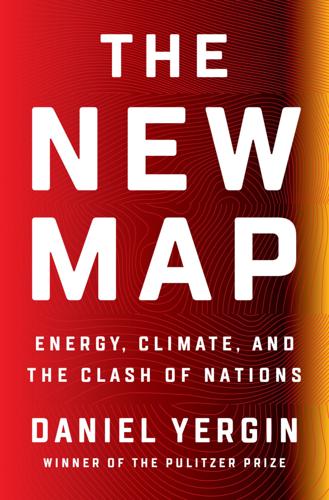
The New Map: Energy, Climate, and the Clash of Nations
by
Daniel Yergin
Published 14 Sep 2020
The revolution was instigated by someone largely unknown in China and indeed the rest of the world—an entrepreneur from a small North Carolina town once known as Shoe Heel. Yet Malcom McLean, otherwise known as “Idea-a-Minute” McLean, is one of the most consequential figures in the history of transportation. Starting off with a tiny trucking company that he built into a major enterprise, McLean went on to unleash the container revolution in world shipping that is the foundation of today’s global economy. There is nothing romantic or flashy about a container; it is a steel box that might be twenty or forty feet long and eight and a half or nine and a half feet high.
…
It was the spread of this innovation, and the networks and system that implemented it, that integrated East Asia into the world economy.2 In 1980, the year Deng began his reforms, McLean initiated the first container service to China. Two years later, the state-owned China Ocean Shipping Company launched container service to the West Coast of the United States. China’s rapid economic growth would not have been possible without the container fleets to carry its goods to global markets with very little additional cost. This applied both to goods manufactured in China and the supply chains for which it was the hub. Seven of the world’s top ten container ports too are Chinese—Shanghai the largest—and China normally accounts for over 40 percent of the world’s container shipments. Trade in turn is almost 40 percent of China’s GDP, making that flow of exports outward, and the flow of oil and other commodities inward, essential for economic growth and indeed the foundations of political and social stability.
…
Yet the “core” countries could be narrowed down to a much smaller number that have signed “comprehensive strategic partnerships” with China.12 Khorgas, once a crossing point through the mountains on the ancient Silk Road, is today the site on the Chinese-Kazakh border of a giant “land port,” a huge railway and transport hub that will speed containers from China on to Europe. Regular train service already delivers containers of Chinese goods to Europe in about half the time it takes for a container ship, though at higher cost. The first regular freight train service to the Middle East reached Tehran in 2016. China is spearheading a $6 billion high-speed railroad project punching through mountains in Laos that will connect China with seven countries and will at some points require tens of thousands of Chinese workers on location.
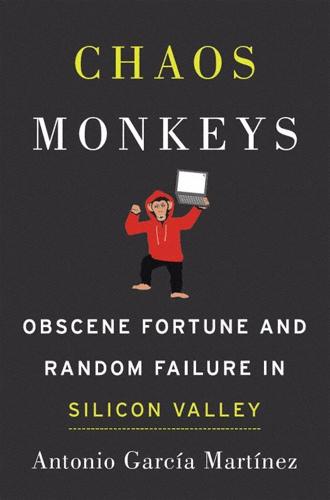
Chaos Monkeys: Obscene Fortune and Random Failure in Silicon Valley
by
Antonio Garcia Martinez
Published 27 Jun 2016
Each part increased in bulk till he became a mountain, and heaven with all its stars rests upon his shoulders. —Thomas Bulfinch, Bulfinch’s Mythology FEBRUARY 28, 2013 Any idea who Malcom McLean was? I bet not. But that one man changed our economy more than practically anyone else in the twentieth century. McLean was the inventor of the intermodal container, those metal boxes piled into immense heaps on the cargo ships coming from China. The genius of the container is that the entire workflow around transporting physical goods is standardized on the same 8×8×40 box. Manufacturers load goods onto eight-foot-wide palettes straight into the box.
…
It’s containerization applied to paid media, and in general, it works. But there are some ships that consider themselves either too big or too important to accept containers—either because they don’t like the look of them on the deck, or because they claim that moving freight is really a side business and not their mission in life. So if you want to move anything through them, you suddenly have to repack everything in whatever arbitrary, random containers these ships accept. This situation is what we politely call “native ad formats” in the ads business. Those ships are products like Google Search, Facebook, and Twitter.
…
Then it displays the associated ad that the advertiser has created and uploaded to Google for that keyword. Actually printing physical money would be harder. So how many such search queries, or “keywords,” in Google-speak, are there? The second edition of the Oxford English Dictionary, released in 1989 and since supplemented, contains 291,000 word entries. The Woordenboek der Nederlandsche Taal, a dictionary of the Dutch language and the largest monolingual dictionary in the world, runs to 50,000 pages and 431,000 entries. Both works are dwarfed by the size of the keyword lists maintained by those lexicographers turned word merchants, the search engine marketers.
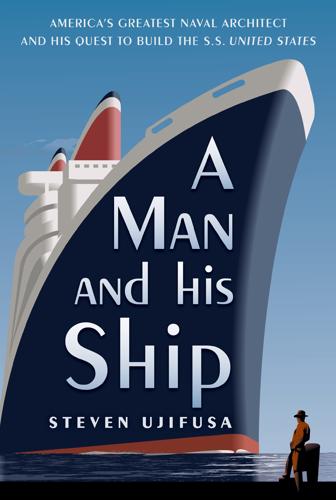
A Man and His Ship: America's Greatest Naval Architect and His Quest to Build the S.S. United States
by
Steven Ujifusa
Published 9 Jul 2012
Top Navy brass began to feel that Gibbs & Cox was “trailing the field, with only a joint General Electric nuclear contract to show.”3 Commercial shipping, meanwhile, was also undergoing a revolution. Until the mid-1950s, cargo had to be offloaded from trains and trucks, hauled to the pier, and lowered into cargo holds. Shipping entrepreneur Malcom McLean’s Sea-Land company changed that by developing a logistical breakthrough called containerization. This was a method by which a sealed container could be lifted directly from trucks and trains and lowered onto a vessel’s deck, and vice versa. Containerization saved shippers a lot of time and money, in large part because it eliminated the need for armies of longshoremen.
…
He knew all along that all of the freight and passenger traffic coming into New York could be monopolized if the piers could be directly tied into the Pennsylvania Railroad and the LIRR. After his secretary told him about his uninvited visitors, Peters strode out of his office, his rosy face showing a big smile. As Peters thumbed through a black leather-bound volume containing the proposal, he said he loved the idea of a Montauk terminal. But when he saw the superliner design, his eyes bulged. It was huge. Not only that, but its proposed turbo-electric power plant had the stamp of approval from William Emmet and its hull by none other than Admiral David W. Taylor. The railroad man stared intently at the two young men and asked what engineering qualifications they had.
…
Commissioner Grenville Mellon, the man who signed the superliner construction contract, admitted that he understood “only vaguely the procedures involved in the staff’s calculations, [and] he claimed to have detected in them mathematic errors which he failed to correct because they ‘were all recited, they were in the record.’”39 Congressman Dawson could barely contain his rage. “You are not given a blank check,” he said, “to say ‘I believe this is convincing, and upon this I am going to do as I please with the Government money.’”40 The commissioner who completely broke ranks was Raymond McKeough, who now rehashed all the objections he had made before finally voting to approve the contract.

The Technology Trap: Capital, Labor, and Power in the Age of Automation
by
Carl Benedikt Frey
Published 17 Jun 2019
While the trucking industry itself fueled American productivity, it also had significant spillover effects on transportation and trade more generally. In conjunction with the rise of the trucking industry, the container revolution was an engine of postwar growth. And containerization emerged directly from trucking. Malcom McLean, a trucking entrepreneur, invented the container as a mean of integrating the segmented industries of shipping, trucking, and railroads. The first successful container shipment dates from April 26, 1956, when McLean’s Ideal-X made its maiden voyage from Port Newark to Houston, Texas. This seemingly unspectacular shipment was, together with Christopher Columbus’s discovery of the New World, one of the key events in the history of trade.
…
Bernhofen, Z. El-Sahli, and R. Kneller, 2016, “Estimating the Effects of the Container Revolution on World Trade,” Journal of International Economics 98: 36–50. 75. G. Horne, 1968, “Container Revolution Hailed by Many, Feared by Others,” New York Times, September 22. 76. Ibid. 77. “The Humble Hero: Containers Have Been More Important for Globalisation Than Freer Trade,” 2013, Economist, May 18, https://www.economist.com/finance-and-economics/2013/05/18/the-humble-hero. 78. R. H. Richter, 1958, “Dockers Demand Container Curbs,” New York Times, November 27. 79. Ibid. 80. On the federal court’s dismissal, see D.
…
In the same way that railroads and steamships paved the way for the first wave of globalization—which abruptly ended with World War I—containerization was the technology that underlay the second wave of globalization, beginning in the postwar years. According to a recent study, the container boosted bilateral trade by 320 percent over the first five years of its adoption.74 The container did not just change the world of trade. Containerization was a driver of Smithian and Schumpeterian growth alike. Contemporaries hailed it as “an extension of our mass production techniques into the carrying of overseas trade.”75 Besides eliminating twelve separate handling steps in the moving of goods between the manufacturer and the consumer, container terminals are estimated to have increased the volume a dock laborer was able to handle from 1.7 to 30 tons per hour.76 Although the construction of such terminals was capital intensive, faster rates of throughput saved substantial amounts of capital—not to mention the capital savings associated with the associated decline in theft.
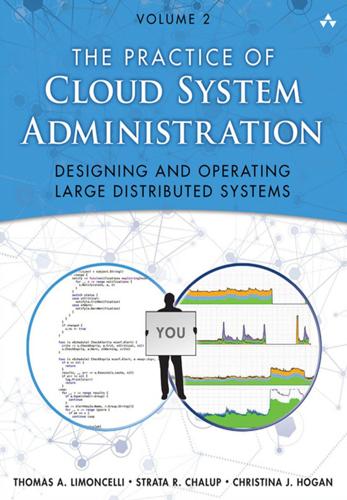
The Practice of Cloud System Administration: DevOps and SRE Practices for Web Services, Volume 2
by
Thomas A. Limoncelli
,
Strata R. Chalup
and
Christina J. Hogan
Published 27 Aug 2014
Customs could approve all the items in a particular container and seal it, eliminating the need for customs checks at remaining hops on the container’s journey as long as the seal remained unbroken. As other modes of transportation adopted the standard shipping container, the concept of intermodal shipping was born. A container would be loaded at a factory and remain as a unit whether it was on a truck, train, or ship. All of this started in April 1956, when Malcom McLean’s company SeaLand organized the first shipment using standardized containers from New Jersey (where Tom lives) to Texas. (Levinson 2008)
…
Solaris containers, called Zones, can be allocated network interfaces and have their network bandwidth regulated to control bandwidth resource contention. Containers on Linux can assign a different amount of disk cache to each container so that one container’s buffer thrashing will not affect the buffers of another container. Processes in a container are isolated in other ways. A container can kill or otherwise interact with only processes in its container. In contrast, processes that are not in containers can kill or interact with all processes, even ones in individual containers. For example, the shell command ps, when running in a FreeBSD container (called a “jail”), displays only processes running in that container. This is not a parlor trick; the container has no visibility to other processes.
…
This is not a parlor trick; the container has no visibility to other processes. However, when the same command is run on the host from outside any container, it shows all processes, including those inside the each container. Thus, if you are logged into the main host (no particular container), you have global visibility and can serve as administrator for all containers. Each container has its own copy of the packages, shared libraries, and other supporting files that it requires. Two containers running on the same machine cannot have dependency or version conflicts. For example, without containers one program might require a particular version of a library while another requires a very different version and cannot operate with the other version installed.